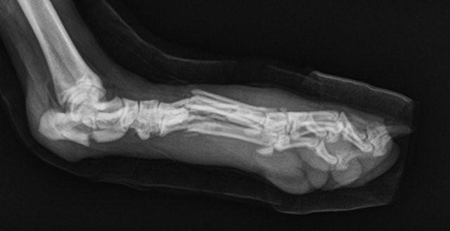Eczema in dogs
 Skin diseases in dogs are not uncommon. The problem is that they can be difficult to diagnose because of the thick coat that hides the symptoms in the initial stages of the disease. Eczema in dogs - one of the most common skin diseases.
Skin diseases in dogs are not uncommon. The problem is that they can be difficult to diagnose because of the thick coat that hides the symptoms in the initial stages of the disease. Eczema in dogs - one of the most common skin diseases. Eczema is called non-contagious inflammatory skin disease, which is allergic in nature. Eczema in dogs can be caused by various causes, among which there are both external and internal.
The most common causes of eczema are external. Under external causes imply a local skin irritation. As external stimuli may act:
skin contamination;
chemical substances;
ectoparasites (lice, fleas, mites);
mechanical irritation (eg, friction from the collar).
However, sometimes eczema is only a symptom that indicates the existence of certain health problems. In this case, it is said that eczema is caused by internal causes. For internal reasons, eczema is:
malnutrition (lack of vitamins, deficiency or excess of animal protein);
chronic diseases;
digestive disorders;
problems with the reproductive system in females (prolonged or sluggish leaking estrus, false pregnancy);
obesity;
old age;
taking certain medications.
Eczema in dogs occurs in several stages: redness of the skin, the formation of nodules,bubbles, pustules, wetting surfaces, scabs (crusts) and scales. Because of the thick coat of the animal, the first stages of eczema may go unnoticed, which subsequently complicates the treatment of the disease.
Therefore, it is very important to monitor the behavior of your dog: some changes in behavior may be indirect signs of eczema. So, eczema in dogs is usually accompanied byitching, so if your dog starts to itch more than usual, it's worth talking to the veterinarian. Also, eczema can be accompanied by weight loss, sometimes with fever and kidney problems.
The diagnosis of "eczema" can only be made by a veterinarian. The fact is that eczema can be confused with other skin diseases - scabies, trichophytosis (ringworm),demodicosis (subcutaneous mite). Therefore, you need to pass tests to exclude these diseases. Also, the veterinarian will determine the form of the disease (acute or chronic) and its stage.
Acute form of eczema is usually localized in places covered with thick hair (neck, shoulder blades, outer thighs, areas under the ears and at the root of the tail). Chronic eczema is more common in the region of the back, from the head and withers to the tail root.
Eczema in dogs is treated comprehensively: first of all, it is necessary to identify and eliminatethe cause of the disease. If the disease has been diagnosed at an early stage, this may be sufficient for the successful treatment of eczema, but more often other methods of treatment are required. These include:
the use of desensitizing drugs (diphenhydramine and calcium gluconate inside, sodium thiosulfate intravenously);
autohemotherapy (subcutaneous or intramuscular injection of a dog's own blood, which is taken from the vein);
a special diet (meat consumption is limited and the share of milk and vegetable food is increased);
reception of vitamins;
local treatment with special ointments.
Do not self-medicate: the veterinarian knows what preparations and in what dosage to prescribe to the animal, depending on the form, localization and stage of the disease. The task of the owner - clearly follow all veterinarian prescriptions and monitor the condition of the dog.
Do not interrupt treatment, even if it seems to you that your pet is alreadycompletely recovered: eczema could go into a latent chronic form. Only when the veterinarian confirms that the animal is really healthy can you stop treatment.














